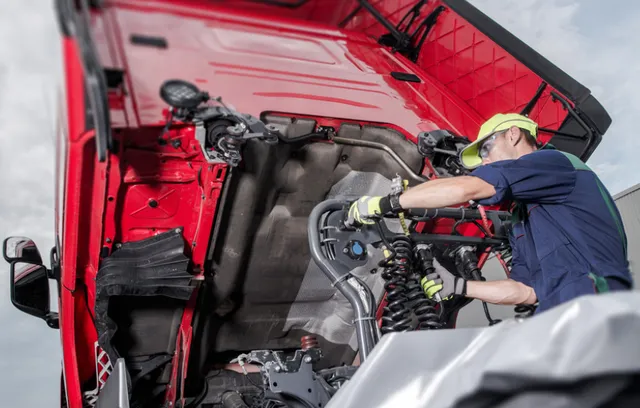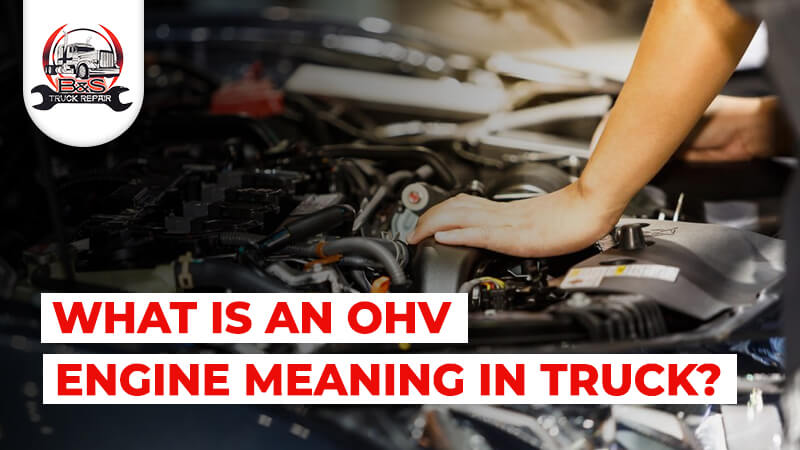The abbreviations OHV, OHC, and DOHC can be perplexing to someone who isn’t familiar with engines while discussing truck engines. “Overhead valve,” or OHV for short, is the name of a particular engine configuration found in many diesel Heavy Truck Engine Repair Services . The term OHV refers to where the valves are located and how they work in an engine. This popular design is found in a lot of buses, pickup trucks, industrial trucks, and other big trucks that require engine alternatives that are both economical and powerful. The compression mechanism and valves of an OHV truck engine are housed in the combustion block instead of the cylinder head.
We will contrast OHC (overhead cam) and DOHC (dual overhead cam) arrangements with OHV layouts. Even though DOHC and OHC designs have advantages in terms of performance, OHVs are still widely used in work applications where low-end torque, dependability, and cost-effectiveness are important considerations. This post will discuss what OHV means, how OHV engines operate, and how their designs differ from those of OHC and DOHC engines. Additionally, we’ll review the various types of OHVs used in truck engines and their advantages.
What is an OHV Engine?
An overhead valve (OHV) engine, called a pushrod engine, mounts the camshaft lower in the combustion chamber. Pushrods are used by lifters, also known as rocker arms, to transmit the action of the cam to the valves in the head of the engine. Conversely, the camshaft and valves are positioned higher in the cylinder head in OHC and DOHC engines. The simplicity, small size, dependability, and affordability of OHV truck engines are highly valued. Because of the cam-in-block arrangement, more capacity is available for more significant displacement in a smaller overall package. By reducing moving mass, the short valve train enables higher RPM operation. With readily accessible components, maintenance is simple. OHVs are perfect for heavy-duty vehicles like trucks and buses because of these advantages.
In contrast to OHC or DOHC configurations, placing the camshaft lower in the block may restrict high-RPM power potential and cylinder head design. However, OHV engines offer the ideal mix of performance and efficiency required in trucks for hauling high loads at lower RPMs.
What Does OHV Stand for in Engines?
OHV is an abbreviation meaning overhead valve. This explains the valve placement of the piston of the engine. The valves of an OHV engine are situated in the combustion head, above the piston that turns the engine. Instead of being up in the head, the camshaft and other valve train parts are lower in the engine block. Pushrods on lifters or rocker’s arms transmit the action of the crankshaft to the valves, causing them to open precisely when needed. In contrast, the camshaft of OHC or DOHC designs are positioned above the engine head openings and immediately operate them.
What Does FFV Engine Mean?
The acronym for “flexible fuel vehicle” is FFV. Fuel for an FFV engine can be regular gasoline or a mixture that contains as much as 85% ethanol. FFV engines provide greater fuel flexibility because they can run on ordinary petrol or high-ethanol combinations. To maximize effectiveness and performance, the engine processor modifies the fuel pump and timing of combustion based on the fuel blend. Some fleet cars and pickup trucks are equipped with FFV capabilities, allowing owners to use other sustainable fuel sources. However, when ethanol is unavailable, the engine continues to function on regular gasoline.
Differences Between OHV and OHC Engines in Trucks
Positioning of the camshaft and valve train is the primary distinction between OHV and OHC truck engines:
- The camshaft of an OHV engine is situated lower in the engine block and uses rocker arms and pushrods to operate the valves.
- The camshaft of an OHC engine is positioned above the cylinder head valves, directly actuating them without the need for pushrods.
Among the principal variations this results in are:
- The camshaft of an OHV is housed in the block, making it more compact and more straightforward. In addition, the engine height is lowered.
- OHC designs eliminate the camshaft from the block, allowing for greater tuning of the cylinder head and valves.
- Although they can’t run at high RPMs, OHV engines are dependable and reasonably priced.
- Although OHC engines are more expensive and complex, they have superior high-RPM power capability.
OHV is often the best vehicle option due to its low-cost torque, simplicity, and compact size. However, OHC designs are used in some contemporary vehicles to boost horsepower and performance.
OHV Meaning in Trucks
The head’s valves are operated by an OHV truck engine’s pushrod valve train, powered by the camshaft. The torque, dependability, and compactness are maximized while this system reduces the cost. When compared to OHC and DOHC, OHV designs, however, have a limited maximum RPM capability. Low-end torque and affordability are essential, and most diesel trucks don’t need power at extremely high RPMs, which makes OHV a perfect fit.
To better grasp how these engines differ from other layouts, truck drivers should comprehend OHV meaning engine. The best engine for your needs can be chosen by weighing the benefits and drawbacks of many variants, including OHV, OHC, and other contemporary versions.
DOHC vs SOHC vs OHV – Which One is Best?
Two overhead camshafts provide the best high-RPM horsepower in DOHC engines.
- SOHC uses a single camshaft for improved airflow and less complexity than older OHV pushrod systems.
- The camshaft of an OHV engine is housed in the block rather than the head, which limits top power but allows for compactness and simplicity. While OHV excels at low-end torque and cost, DOHC gives the most energy.
- OHV is frequently the best truck compromise, even though more efficient current OHC is available.
In summary, SOHC strikes a balance, DOHC maximizes power, and OHV prioritizes torque and economy.
What is OHV, OHC and DOHC?
The valve train arrangements OHV, OHC, and DOHC indicate the arrangement and quantity of camshafts inside the engine:
| OHV | OHC | DOHC |
| The overhead valve (OHV) is a single camshaft in the combustion block. Compressor head valves. | A single camshaft is located in the cylinder head next to the valves, known as the OHC or overhead camshaft. | DOHC refers to the dual overhead camshaft, or intake and exhaust valves, positioned in the cylinder head. |
| The tiny, easy-to-use, reasonably priced OHV engines are called “pushrod engines.” They can, however, restrict functioning at very high RPMs. | While more complicated, OHC designs provide better ventilation and high-RPM power capability. | DOHC engines provide the most peak power among the most sophisticated and costly engines. |
The best compromise for trucks is frequently OHV, which provides superior torque and drivability over OHC or DOHC. To improve efficiency, some contemporary truck engines now use OHC designs.
Types of OHVs Used in Truck Engines
Although there are several OHV truck engine varieties, there are primarily two:
Wedge engines
The intake and exhaust valves on these less complex OHV truck engines are parallel to one another rather than splayed, and the engine boxes are cylindrical. Wedge-head OHV designs, such as the Ram was used in GM and Ram Trucks.
Vee Engines
Instead of being in line, the cylinders in vee OHV engines are arranged in two angled banks. Instead of being parallel, the combustion chambers and valve angles are splayed outward. Vee OHV engines power the Power stroke diesel engines found in Ford and Dodge trucks.
Additional OHV variants, including “canted valve” designs, can maximize ventilation and improve combustion efficiency.
Choose Best Truck Repair Shop For Your Truck Today!
- Affordable
- Quick Fix
- Boost Truck Performance

Conclusion
OHV truck engines are still in demand because of their affordable price, simple construction, and low-end torque that can lift stumps. While more RPM power is possible with OHC and DOHC, most diesel vehicle needs are satisfied by the high torque, dependability, and efficiency of OHV. Truck owners need to know the OHV language and design to choose or maintain their engines with knowledge. Contact the B&S Truck Repairs team for professional heavy truck engine repair services. Their specialists are very skilled in working with all varieties of diesel engines, including OHC, OHV, and more recent models.

